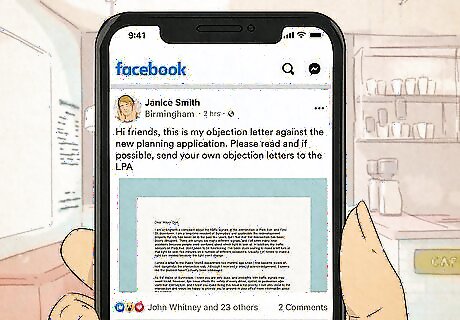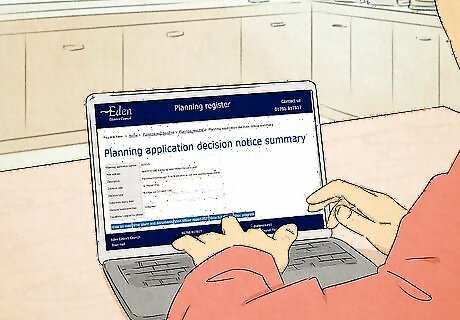
views
Locate the appropriate local authority.

Planning permissions are governed by the Local Planning Authority (LPA). The UK government website allows you to search for the appropriate LPA by naming the place of interest or postcode. Once you find your LPA, click the link to the homepage of the governing council and local procedures. Depending on the LPA, you may be able to file your objection to a planning application online. For example, for the Kent County Council, you can contact the case officer to discuss the application and then file your comments and objections through the website. It's important to submit your objection to the correct LPA, so research thoroughly and write down the planning application number for reference.
Review the planning application.

Each LPA maintains a public register of planning applications. The applications are available for anyone to review. You may need to go to the LPA office and review the application in person, but in most cases it’ll be available through the website of your LPA. New planning applications are often published in the local newspaper, too. You'll be able to look at information about the developers, the planning application form, and all supporting drawings, maps, elevations, tree surveys, and other engineering renditions. Application review can be done on your own or with a committee. You’re not required to be part of an organized group to file an objection to a planning application. Consider visiting the building site to take notes and/or photos (you can submit photos as evidence in your objection). Don't trespass, though! Stay on the public right-of-way or ask the landowner for written permission. Keep in mind that the landowner may refuse since you're gathering evidence for an objection.
Identify your specific objections.

Dig into the application to find valid reasons to back up your arguments. Work through the application plan and detail every objection that is a valid material planning consideration. Note concerns about negative effects the project may have on the quality of life in residential areas including noise, smell, loss of greenspace, loss of sunlight, and traffic. Valid objections include: Excessive tree or hedgerow removal can affect drainage, soil stability, wildlife habitat, hunting, atmosphere, and appearance of the area. Loss of privacy at your residence or business space. Noise and traffic that affects living conditions, tourism, and quality of life. Concerns about pollution of native waterways from industry or agri-business and how that could affect water supplies, fishing, tourism, and wildlife. Stress on infrastructure, including waste disposal, roads, parking, and schools. Architecture that is out-of-character with existing historical structures and could negatively affect tourism and the charisma of the neighborhood. The development’s impact on property price isn't a valid objection. You also can't object based on reputation, ethnicity, religious beliefs, or sexual orientation of the developer.
Put your formal objections into writing.

Focus on detailing each valid objection in a clear and concise way. Pick your battles and choose the parts of the project that would have the biggest effect on the area and your community. Aim to include at least 3 clear and specific objections to the development. Include your reasoning for each one and back it up with evidence, if possible. Be concise; aim for no more than one-half page per objection. A few things to remember: Include the application plan reference number in your commentary. Your objections will be posted publicly. Use a professional tone. Write in your own words. It can be helpful to look at objection letter examples online, but use them as guidance; don't copy and paste from them. Include your name and address. The LPA may not publicly post your name, but you have to include your name for the objection to be valid.
Submit your objection commentary to the LPA.

You can send an email, post on the LPA comment page, or mail a letter. Remember to file objections within 21 days of the publication of the planning application. Late comments may be accepted, but you should aim for the deadline date. If you mail your objections, be sure to allow several days for delivery. Typically, there's no fee to submit a comment or objection. That said, some councils may charge a small fee if you submit your objection through their online portal. You can also hand deliver your letter to the LPA office if it’s in your neighborhood.
Share your concerns with the community.

Get the word out so that other locals can join the cause. For example, you can post your objection letter on your personal social media accounts and in local community groups on Facebook. Encourage concerned community members to send their own objection letters to the LPA to address their concerns. Make sure each person submits objections individually for the most impact. For example, a single letter with 20 community signatures won’t have the same impact as 20 individual letters from different names/local addresses. You can add power and garner support for your objection by speaking at local government and council meetings, as well. Contact the council for instructions on how to be put on the agenda.
Watch for the LPA's decision notice.

Typically, the decision notice is posted on the planning register. Most objections are reviewed by local planning officers, but some may be decided by the Planning Committee. Once the decision is made, the LPA will post the notice publicly. The announcement will include one of the following outcomes: Approved (possibly with conditions). Refused. Deferred to enable amendments or further information to be submitted. Deferred to enable the Planning Committee to visit the site. It's possible to appeal a decision if you aren't happy with the outcome. Contact your LPA for more information about this process.



















Comments
0 comment